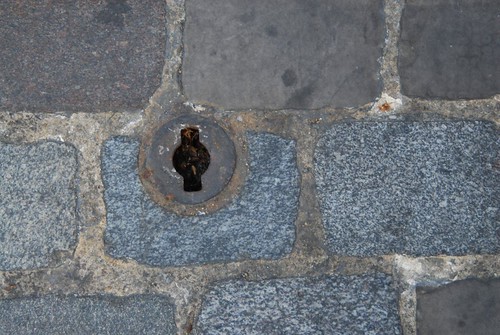With Paris’ obsession for constantly cleaning the streets, I was not entirely surprised to see designated trash collection areas at a couple of markets [some with a cleaning crew present during market hours!]
Unfortunately, Monge Market didn’t have the same facility, but people improvised.

However, we all know that by the end of the day, the cleaning crew would be there after each market to turn this [Maubert Market]:

There is certainly no shortage of water on the streets of Paris with its daily street cleaning routine. In addition to the cleaning trucks, water valves are released twice a day, creating a a network of urban streams that flow along the curbs or in the middle of the streets. Apparently, the flushing of the streets has been going on from as early as the turn of the 20th century. Is water perceived as a sanitizer rather than a thirst quencher? Is that why most fountains in markets are not used?
Sad, but true: pay phones have gone the way of the dodo. Phone booths, however, remain, but what to do with them? This example is just taking up space at Place Monge–even the vendors have turned their backs to it.
Suggestions? The phone booths are linked up to power and data sources–how could this add to the life of the market?
At the Monge Market, the fountains were largely ignored as a water source and were certainly does not attract large numbers of people (unlike Rome…see earlier posts: A little water? & Nero on fountains). As seen below, one is not used at all while the larger centerpiece has transformed into a trash collection area.



This is the only functioning one, but it was off on the edge of the market and was used very little (probably mostly by vendors).

This fountain at Bourse Market was used, but by a vendor.
Why the differentiation? Is it a feasibility issue? A functional issue? An aesthetic decision?
Elevated power sources at Maubert and Raspail Markets
Recessed power sources at Bourse and Monge Markets


There are dozens of roving markets in Paris. From the few we’ve seen so far, the market stalls use the same structural framing system that anchor into the ground. Does this standardized organizational system restrict market vendors from adapting to their own needs? How are these organizational patterns established in the first place? Do they respond to or impact market surroundings? Do the structural frames migrate from one market to another?
Baudoyer Market (at Place Baudoyer) one day before the market day

Baudoyer Market (at Place Baudoyer) two days before market day

Maubert Market (at Place Maubert) one day before market day

Organizational couplings in the ground | Baudoyer Market

Footing of vendor stall frame
At Maubert Market, the skeletal framework creeps into the street…
…and signs of market growth with patched asphalt.
We walked by Place Maubert today, scouting out the street in advance of tomorrow’s market. The skeletal beginnings of market stalls (so different from those in Rome!) already inhabited the median and spilled into the street.
__________
My favorite part of the set-up was the way the scaffolding wove its way around the site’s trees. The effect was a bit forest-like, with steel and asphalt subbing in for tree bark and moss.
Jie picked up a copy of Nero at the American Academy last week, and we’re just now getting around to looking through it. One excerpt addresses the public fountains throughout the city:
An English friend of ours says that Rome is the best city to live in if you’re a bum. One of the reasons could be that it’s full of fountains, and above all drinking fountains, continuously flowing with fresh spring water. Which allow you, for example, to shave and freshen up after sleeping under a pine tree in one of the city’s marvelous parks. Finding yourself in front of the crystalline stream, you feel like you’re in Arcadia, the pile of garbage facing you no less than a Greek temple. (p. 27, Nero, No. 23)
We’ve noticed that while the Campo de Fiori’s buried electrical infrastructure is all but ignored, its lowly drinking fountains are huge attractors. People use them for drinking water, to wash fruits and vegetables, to freshen up wilting flowers, and even to mix concrete for nearby construction projects.




















